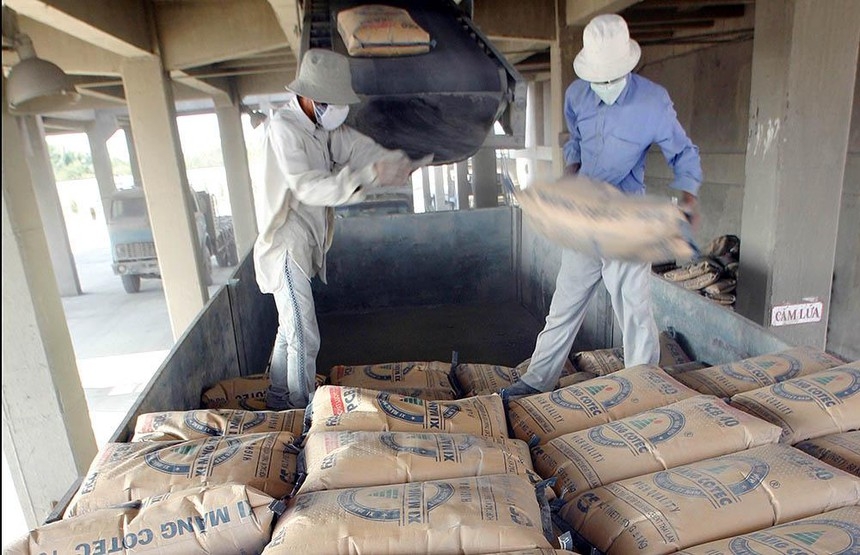Higher clinker export duty proposed to restrict export of natural resources
 |
| Cement and clinker are not encouraged for export due to their massive use of natural resources |
The Ministry of Finance (MoF) included the proposal in the draft decree on amending and supplementing several clauses of Decree No.57/2020/ND-CP and Decree No.122/2016/ND-CP presenting export-import tariffs.
In fact, boosting cement and clinker exports would help the local cement industry to take advantage of abundant local production, but it is not a sustainable solution on the long term as the production of these two items mainly leverages the use and exploitation of non-renewable natural resources.
The MoF argued that the increasing exports of clinker have depleted local natural resources, causing detrimental impacts on the environment.
The annual report of the Vietnam National Cement Association shows that by the end of 2020, Vietnam was home to 90 clinker and cement production lines with a total capacity amounting to 106.6 million tonnes.
| The Vietnam building material development strategy for 2021-2030, with vision to 2050 also set an orientation to restrict export of products using materials or fuel deemed as non-renewable. |
Local cement consumption has seen almost no growth in recent years and has even dropped three million tonnes last year against 2019. Consumption still surpassed 100 million tonnes thanks to a sharp rise in export volume.
According to the MoF, Vietnam exported nearly 33 million tonnes of cement and clinker last year, including 24 million tonnes of clinker, representing 73 per cent, and 8.7 million of cement (27 per cent).
While Decree 57 set an export duty of 5 per cent on clinker, Vietnam's building material development strategy for 2021-2030 with a vision to 2050 set the orientation of restricting the export of products made from materials or fuel that is non-renewable.
Particularly, the strategy mandates that the proportion of clinker and cement export must not exceed 30 per cent of the total designed capacity of the sector in 2021-2030 which will be reduced to 20 per cent during 2031-2050.
It is noteworthy that clinker and cement exports have already reached this limit.
According to a report by FPT Securities, in the past decade (2010-2019) Vietnam’s cement exports rose 30-fold, accounting for 32 per cent of the whole sector’s total output and turning Vietnam into a top cement exporter.
However, while export volume grew, Vietnam has remained at the lower reaches of the supply chain, with exports mostly consisting of clinker, the raw form of cement with very low added value.
The Free on Board (FOB) price of one tonne of clinker costs only $38.5 at Vietnam’s ports, about 10 per cent lower than the price of cement in the domestic market.
Nguyen Cong Bao, managing director at Malaysian-backed cement firm Fico-YTL, one of the leading cement firms in the southern market, noted that amid escalating pressure to ensure energy security and the government’s commitment to protecting the environment, it is important for the cement industry to focus on serving the domestic market. Once domestic supply is secured, the government will be able to present suitable policies on balancing supply and demand.
What the stars mean:
★ Poor ★ ★ Promising ★★★ Good ★★★★ Very good ★★★★★ Exceptional
Related Contents
Latest News
More News
- Six localities record double-digit growth as regional performance diverges in 2025 (January 06, 2026 | 18:00)
- E-commerce market undergoes transformation amid rising competition and regulation (January 06, 2026 | 17:54)
- Vietnam’s industrial output hits seven-year high in 2025 (January 06, 2026 | 17:47)
- GELEX’s credit rating outlook upgraded to 'Positive' by VIS Rating (January 06, 2026 | 16:49)
- Finance sector lays firm groundwork for 2026 after major reform (January 06, 2026 | 15:30)
- Vietnam’s seafood exports surpass $11 billion in 2025 (January 06, 2026 | 08:51)
- Vietnam GDP posts second-strongest growth since 2011 (January 06, 2026 | 08:35)
- Double-digit GDP growth within reach with shift to higher-value expansion (January 06, 2026 | 08:33)
- Takeda Vietnam awarded for ongoing support of Vietnam’s sustainability efforts (December 31, 2025 | 21:00)
- Vietnam's retail market tops $269 billion in 2025 amid e-commerce boom (December 31, 2025 | 19:00)

 Tag:
Tag:



























 Mobile Version
Mobile Version